
Sydney Rows
A Centennial History of the Sydney Rowing Club, 1970, by A L May
Table of Contents
Chapters
- Preliminaries: before 1870
- Foundations: 1870-1880
- New Clubs: 1880-1890
- The Amateur Question: 1890-1900
- Sydney on Top: 1900-1910
- Henley and War: 1910-1920
- Pearce and Mosman: 1920-1930
- Financial Problems: 1930-1940
- War and Wood: 1940-1950
- Strength and Stability: 1950-1960
- On Top Again: 1960-1970
Appendices
8. Financial Problems: 1930-1940
Other Clubs
Mosman's long run as premiers came to an end in 1932/33 after a sequence of eleven years. In 1934/35, however, the club regained the premiership and also won the junior pennant. Mosman was premier again in 1936/37 but, thereafter, its performance waned quite considerably. The need for new premises became particularly urgent when, in 1932, Mosman Council ordered the old Mercantile building demolished.
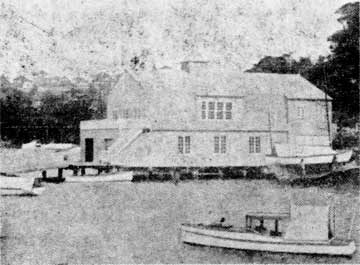
Mosman's new shed
Opinion in the club was split, however, as to whether the shed should be rebuilt on the existing Mosman Bay site or transferred to the Spit. At the 1932 general meeting, a secret ballot resulted in a 35-all tie. It was finally decided to rebuild in Mosman Bay, and the new club house was opened in September, 1934 by Sir William Cullen, the club's first and only patron to that time. Expenditure on the new building was about £1,120.
Haberfield performed with distinction on the river in the 'thirties. It won the junior pennant in both 1930/31 and 1931/32, gaining second place in the premiership in both years and again in 1932/33. Bernie Williams continued to be the architect of much of the success. Wins continued to come fairly frequently thereafter, and the junior pennant was won again in 1936/37. Haberfield's greatest success ever came in 1938/39, when both the premiership and the junior pennant were won, and the performance was repeated in 1939/40.
Leichhardt's supporters had some excitement in the decade, but the premierships were always well distant. The club celebrated its 50th jubilee in 1936 and had hoped to have a new boat shed erected, but financial problems forestalled the proposal. A new shed, costing £1,050, was finally opened in May, 1940. Also successful in the club house sphere was North Shore, which opened a branch club house on the Lane Cove near Longueville wharf in November, 1933. Success on the river all but escaped the club altogether, however, until the one glorious year of 1937/38 when the premiership was won for the first time since 1894/ 95. Even more remarkable was the fact that the club failed to score a single point in the junior pennant that year.
Glebe and Drummoyne had almost no success at all in the decade and the latter had more problems when its boat shed was almost blown over in 1938. Balmain fared poorly until the last two years of the period when the club finished second in the premiership both times. Cec Pearce, a cousin of Bob, gained a string of wins for the club at this time.
Nepean's financial position was sound, but a second in the junior pennant in 1939/40 was by far its best rowing effort of the decade. Sydney University was seen only rarely in open races during the 'thirties, but certainly made its mark in the intervarsity races for the Oxford and Cambridge Cup. Six wins and four seconds in the ten-year period was its proud record. The other winners were Melbourne (two), Adelaide and WA. By the end of the decade, Sydney had scored a total of 20 wins in the competition to Melbourne's 17, with Adelaide next best with 5.
The NSW Police Rowing Club was by far the most significant of the new clubs in the decade. It was formed in 1933 and erected a shed on Blackwattle Bay. Many Police officers from other clubs soon joined up, including George Hancock as captain. Success was quickly forthcoming with the junior pennant being won in its very first season. The greatest heights were attained, however, in 1935/36 with a win in the premiership and its senior eight being selected for the Olympic Games in Berlin.
The practice of old boys of GPS schools forming eights to provide pace for their school crews led to suggestions early in the decade that a GPS old boys' club be formed (an equivalent club in Brisbane being the leading Queensland club). A maiden eight from King's School Old Boys competed in 1931 and, in 1932, the Old Newingtonians Rowing Club was formed, Frank McLeod being among the prime movers. It started crews in races and a member won the 1932 Walker and Hall Cup, but it disbanded after two seasons.
There was interest in the country rowing scene when the Pittwater Aquatic Club decided in 1935 to reform as an amateur club and to affiliate with the NSWRA. The reinstatement of a number of members as amateurs was achieved and in 1937 a new boat house was opened. The club promptly then won the junior pennant by a large margin and also finished second in the premiership.
A number of other country clubs also affiliated with the RA. Lismore and the new Windsor club did so in 1938 and, in the 1939/40 season, the newly-formed Leeton, Brighton and Newcastle Rowing Clubs affiliated. Unsuccessful negotiations with Grafton took place in 1935. The Kembla Rowing Club at Port Kembla was formed in 1935 and new clubs were formed at the end of the decade at Narrandera and Griffith.
In Sydney, O'Donnell Griffin maintained their record to win the third and last City Houses championship in 1930, while Treasury made it four out of four in the Public Service championship in 1932. The last event in this series took place in the following year, with Police being successful.
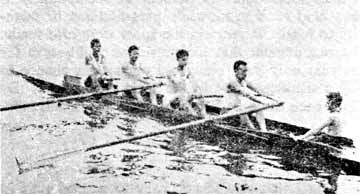
The Treasury Four which won the Public Service Championship in 1932
E L Shearer (bow), F Hume, G E May, H W Gilmour (stroke), A Nickson (cox)
Interclub contests in the winter months continued, stimulating interest among oarsmen in the off-season. Sydney took the honours in the Cock-o'-the-Harbour, with five wins and a tie to North Shore's four wins and a tie. Three seconds was Mosman's best effort. The events were keenly contested, with Sydney's three wins in 1933, 1934 and 1935 all being by one point only.
In 1932, Glebe joined Balmain, Leichhardt, Haberfield and Drummoyne in the popular J. B. Sharp series. In 1934, however, it "deserted" when competition for the "Head" of Blackwattle Bay was revived with Police and University being the other contestants. Glebe won the "Toxteth Cup" in the first year but, thereafter, Police proved much too good. Clubs not directly concerned were welcome to start by invitation in all three competitions. During the first Toxteth Cup series, indeed, an unclassified eights event attracted 13 entries. The result was a "hopeless mix-up".
A new organisation of rowing men appeared in NSW early in the decade. At the meeting of the AARC in 1929, the suggestion was made that a League of Old Oarsmen be formed. With Ossie Wood to the forefront, the idea was taken up in 1931 by the NSWRA. A meeting was convened and "a small but enthusiastic gathering of rowing men" decided to inaugurate the "Union of Old Oarsmen". A further meeting confirmed the resolution and the "Foundation Reunion", attended by about 80 old rowing men, was held in November, 1931.
The body's aims were to foster a spirit of good fellowship among all men who had rowed and sculled, to maintain an active interest in the sport, and to assist the NSWRA in regard to the financing of the annual interstate crew. Judge Backhouse became patron, Judge Alex Thomson the first president and Harry Alderson chairman.
The Union affiliated with the RA and two delegates were soon attending its meetings. By 1936, membership had reached 203 and a donation of £20 was being made to the Association. A number of social functions were held each year, while presentations to members to mark 50 years in the sport were also made. The requirement that the president could serve for one year only gave many old oarsmen a chance to play a significant role in the sport once again. By 1938, each State had formed such an organisation.
Racing
Australian rowing got away to a good start in the new decade. Bob Pearce won the Empire Games sculling in Canada by 3 lengths, Jack Beresford of England being the runner up. England scored a narrow win in the eights at the Games from NZ, with Australia not represented. This time, Pearce did not return home in triumph, deciding to settle instead in Canada.
With no King's Cup being held, the main interest in the 1930/31 season was whether Sydney could dislodge Mosman from the premiership. The club's confidence was dashed, however, at the Mosman regatta in October, 1930, when Mosman, with only two experienced oarsmen, scored a clear-cut win over them in the senior eights. While third behind Mosman and Glebe was the best Sydney could do in the champion fours soon after, the club went on with its plans to race at Henley-on-Yarra once again. Sydney beat Albert Park in a heat of the Grand Challenge Cup, but was beaten by Mercantile in the final by 1/2 length. The crew was Downie (bow), Whitworth, Baber, Pike, Lester, Nickson, Harkness and Lambert (stroke). Jack Goulding also made the trip and scored an easy win in the final of the sculls.
Back at home, Sydney's eight did well, with wins over Mosman at Sydney's own regatta, at the Leichhardt-Haberfield Regatta on Tarban Creek and in the Riverview Gold Cup. In the champion eights, however, Mosman trounced them by 6 lengths. Goulding caused a surprise in the champion sculls with a comfortable win over Scott, the Australian champion. He also won another marathon event-Gladesville Bridge to Ryde Bridge and back twice-rowed in May, 1931. In the premiership, Mosman scored another easy win.
Mosman crews also dominated the 1931/32 season. The St. Joseph's College regatta opened the racing with an ex-Joeys oarsman, Bill Dixon, stroking Sydney to a win in the maiden fours. The champion fours of NSW went to Mosman from Haberfield and Sydney. There was additional interest in the Pittwater Regatta in December: a crew in Leichhardt colours won the senior eights but the judge, Claude Rosevear, discovered Bruce McFarlane of Glebe in the stroke seat and awarded the race to his own Sydney crew which had finished second.
Ossie Wood was again appointed sole NSW selector and he had five crews to watch in the champion eights. At the finish, however, there was only one in the picture, Mosman winning by 8 lengths from Leichhardt and Haberfield. Sydney, with a number of new and light oarsmen, finished fourth. There was a turn-up in the champion sculls: Herb Turner of Haberfield had an easy win over Jack Goulding, the latter having easily defended his Henley-on-Yarra title only a short time before.
Bert Goulding took out the lightweight champion sculls of NSW, however. When the lightweight champion eights were rowed a little later, Drummoyne scored its third successive win. Wood selected the entire Mosman eight to represent the State, with Reg Daly as coach. Geoff Hilder, who had devised an extensive land training schedule for the crew, was also appointed trainer of the State eight. The race was to be in Melbourne and, one week before, a grand parade of crews took place on the Yarra, the interstate crews being amongst the 36 eights, 9 fours and 7 scullers taking part.
The King's Cup went to Victoria for the second time in succession, with NSW 2 lengths back and WA third. Alec McLeish, the Victorian stroke, earned great praise for his efforts. Herb Turner won the sculls twice: poor steering by all scullers marked the first contest and, after a protest, a re-row was ordered.
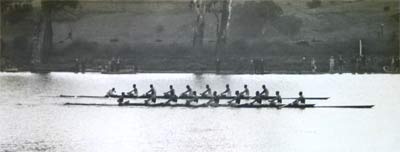
1930 King's Cup with Victoria leading NSW
An additional feature of the 1931/32 season in Sydney was the "Bridge Opening Celebrations Regatta" in March, at which five races were rowed. A special dance was also held at the SRC Branch to celebrate the occasion further.
Attention now turned again to Bob Pearce. In 1931, he won the Diamond Sculls at Henley Royal Regatta and he indicated he would row for Australia at the 1932 Los Angeles Olympic Games, if selected, at no cost to the Australian Olympic Federation. The selection was duly made, Pearce being the only oarsman in the small Australian team. (There was, however, an unsuccessful movement to nominate Jack Goulding to contest the double sculls with Pearce as well.)
Major Goodsell assisted Pearce in his training and declared Pearce would have to capsize to lose the event. So it proved. While his winning margins were smaller than in Amsterdam, in the final, against Bill Millar of USA, he led from the start rating 28 and then came down to 24 while Millar was up to nearly 40. Pearce was content to maintain a 1/2 length lead only and this was the winning margin. There was general agreement that he was, indeed, the greatest sculler the world had ever seen. A year later, he turned professional and soon dominated that field as well.
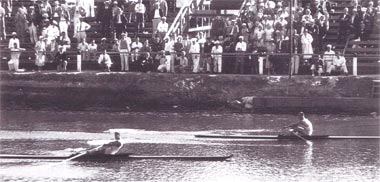
Pearce winning gold at the Olympics in 1932
Sydney won the champion eights in the 1932/ 33 season. The first indication of the crew's strength came at the Mosman regatta, when it beat both Haberfield and Mosman. Sydney's crew, which had done extensive land training during the winter, was boated Frank Leister (bow), Dick Norrish, Bill Dixon, Fred Pike, Frank Lester, Tom Nickson, Geoff May, Cliff Lambert (stroke) and Chummy Nickson (cox). A sculling relay race was a feature of this regatta.
Sydney's success in senior rowing continued, the crew of Dixon, Nickson, May and Lambert winning the champion fours for Sydney for the first time since 1912. At Sydney's own regatta in December, 1932, the club won the senior eight, lightweight junior eight (the first ever held), the junior four and the maiden four.
In the champion eights, Sydney beat Mosman by just over a length to give the club its first win since 1908/09. In the champion sculls, Max Fisher of Drummoyne was successful although other entrants, including Turner, the Henley-on-Yarra winner, were affected by a series of clashes. Basil Martin had a runaway win over Bert Goulding in the lightweight champion sculls. Successes for Sydney continued in other events-one oarsman, George Wood, stroked nine crews to victory in the season-to confirm wins in both competitions for the club.
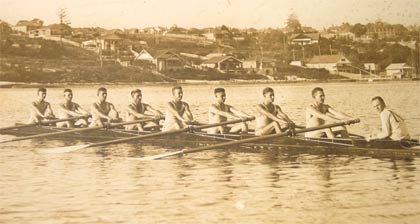
1933 NSW King's Cup crew
It had been decided, meanwhile, to revert to the holding of King's Cup contests annually and the 1933 event was on after all. Wood did not stand for the position of selector for 1933 and Bernie Williams of Haberfield was elected to the post. The crew finally selected contained five Sydney men - May, Dixon, Lester, Nickson and Lambert - together with Bromley, Jordan and Shepherd of Mosman. Keary won the ballot for coach. A test race for selection of the sculler was held, with only Turner and Fisher invited to compete.
This time Turner had an easy win. In the race in Brisbane, NSW led from the start to beat Queensland by 1 1/4 lengths, with Victoria 10 lengths back third. The work of the NSW crew was "clean, they had a good lift in their boat all through, and they swung into it with a precision that left no doubt as to their stamina". Turner had a practice row in the sculls, winning by 100 yards, while both eight and sculler set new record times.
Rowing in the Queensland eight which finished second to NSW in the 1933 King's Cup was Percy Finney, a blind oarsman, who rowed in the winning Queensland eight in 1924 and was later involved in a shooting accident.
